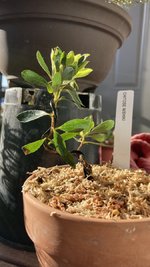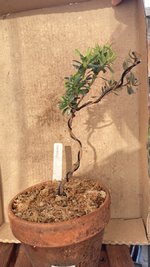Glaucus
Omono
How to bend is very well explained in that Koya.nl article, by the head instructor of the Japanese satsuki society. Including hand placement and how to bend, when to use rice paper, when to use both copper and alu wire (if I remember correctly).
If needed, I can translate back to English.
It is challenging to grow pliable tall whips, and then to bend them as well.
I think now might even be on the early side for bending.
And best not to snap. I had some 2 year whips directly from Japan. These were already hard to bend. I even snapped one near the apex.
And others have very poor movement. Maybe I got them too late. Maybe I buy them in spring as 2 year old whips. But I received them the winter after, because of imports and the timing of this during winter.
About the flowers, if you want to keep them, no worries. Especially if it is a cultivar with variable flowers and you'd rather keep the branch with the correct flowers as leader.
You can prune later. Between now and flowering, you won't receive any permanent reverse taper.
I think John/DSD is one of the few people in the US that grows very tall whips out of cuttings.
I am also considering putting in some extreme bends in a satsuki once. Like almost bending in on itself, like is sometimes done with pines.
Sometimes, the Japanese almost put knots in some of those pines or junipers. That can give a lot of character long-term. Maybe also in satsuki?
If needed, I can translate back to English.
It is challenging to grow pliable tall whips, and then to bend them as well.
I think now might even be on the early side for bending.
And best not to snap. I had some 2 year whips directly from Japan. These were already hard to bend. I even snapped one near the apex.
And others have very poor movement. Maybe I got them too late. Maybe I buy them in spring as 2 year old whips. But I received them the winter after, because of imports and the timing of this during winter.
About the flowers, if you want to keep them, no worries. Especially if it is a cultivar with variable flowers and you'd rather keep the branch with the correct flowers as leader.
You can prune later. Between now and flowering, you won't receive any permanent reverse taper.
I think John/DSD is one of the few people in the US that grows very tall whips out of cuttings.
I am also considering putting in some extreme bends in a satsuki once. Like almost bending in on itself, like is sometimes done with pines.
Sometimes, the Japanese almost put knots in some of those pines or junipers. That can give a lot of character long-term. Maybe also in satsuki?




